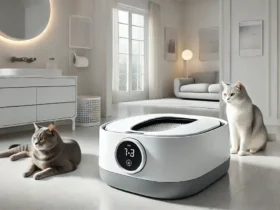Introduction
If you’re a cat lover and also you have cats, it is a great concern that “How many litter boxes per cat?” Before buying or bringing a cat into the house cat owners sometimes ask a question and sometimes they think that one litter box is right for a cat. Is it good for your cat’s health and happiness? On the other hand providing the right number of litter boxes can prevent accidents, reduce stress, and ensure a harmonious home and especially when you have multiple cats. Let’s explain everything you need to know about litter box requirements, starting with the golden rule: one litter box per cat, plus one extra.
The General Rule of Thumb
The general golden guideline for litter boxes is simple: one box per cat, plus one extra. If you have two cats, you should provide three or four litter boxes. As a result, it will ensure that every cat has their own space while also accounting for unexpected needs, such as a dirty or unavailable box.
Why This Rule Works
Cats are territorial animals, and if you have multiple litter boxes then it will help your cats to feel secure. Also, it minimizes the risk of litter box competition and ensures your pet friends always have access to a clean space when nature calls and multiple boxes also help to prevent any kind of accident.
Why Cats Need Multiple Litter Boxes
Providing enough litter boxes isn’t just necessary for your cat. But it also ensures that you give priority to your cat’s choice.
Behavioral Needs and Territorial Instincts
Cats often prefer their own area for toileting. Moreover even in a single-cat household, your pet might like having options, especially if the box becomes soiled or is in a less-than-ideal location.
Avoiding Litter Box Competition
In multi-cat households, territorial disputes can arise. Having enough boxes reduces the chances of fights or one cat monopolizing a single box, which could lead to stress and accidents.
Preventing Accidents
When cats don’t have a clean or available litter box, they start using carpets or furniture as their toilet. If you have more boxes then this chance can be reduced.
Factors Influencing the Number of Litter Boxes
Single vs. Multi-Cat Households
Although a single cat always does not need two or multi-litter boxes, if you have an extra then it will be helpful. For example, in multi-cat homes, the ratio is 1:1+1 and it becomes hard to maintain peace.
Size and Layout of Your Home
If you have a large area in your house and place the litter box in an appropriate place then it can ensure easy access for your cat. However, in small spaces, creative placement is key to meeting your cat’s needs without compromising your living area.
Cat Personalities and Preferences
Some cats are more different than others. If your cat refuses to share the litter box with others then you should provide another box for your cat also.
Single Cat Homes: Litter Box Considerations
Even for a single cat, two litter boxes are very helpful and beneficial. Cats may prefer separate boxes for urination and defecation. Set them in different locations to explore what works best for your feline friend.
Multi-Cat Homes: Special Considerations
Living with multiple cats means maintaining harmony between all the cats. Keep litter boxes in different rooms to stop territorial disputes, and always have more boxes than cats to accommodate individual needs.
Common Mistakes Cat Owners Make
Not Following the Rule
Many cat owners think one box is sufficient even in multi-cat homes. But it is completely wrong. This mistake often creates stress and behavioral issues in cats.
Poor Placement of Litter Boxes
If you place all the boxes in one area and also hard-to-reach areas can create confusion and discourage your cat from using them.
Ignoring Cleaning Frequency
Cats are clean animals. Although a dirty litter box can be the reason for not using the box then you should keep the box clean.
Choosing the Right Litter Box
Litter boxes have various shapes, sizes, and designs. The right one for your cat depends on their size and preferences. So according to their size and choice, you have to choose the litterbox also.
Covered vs. Uncovered Boxes
While covered boxes offer privacy, some cats also prefer open ones for better visibility. Experiment to find what suits your cat. Some cats prefer to use covered boxes because they think they can maintain their privacy and at the same time they can use them peacefully.
Understanding Cat Behavior Around Litter Boxes
Cats communicate with you and express their needs in subtle ways. However you should pay attention to signs like litter box avoidance, which can be an indication of the need for extra boxes or a change in placement.
Litter Boxes Placement in House
Set up your litter boxes in easily accessible and peaceful locations where your cat can easily enter and use them and eliminate their poops. Right placement and peaceful leaving can be very helpful for a cat’s health. Do not place litter boxes in noisy or high-traffic areas that can discourage your cat from using the litterbox. In particular, cats are very sensitive so keep all these things in mind when deciding on the placement of the placement of the litter box.
Cleaning and Maintenance Best Practices
Scoop litter boxes daily and change litter weekly. A clean litter box keeps your cat happy and your home odor-free. Do not use bleach and use lukewarm water and mild germ killer soap. Wash your hands with germ and bacteria-killer soap.
Especially What Happens if You Don’t Clean Enough?
If you do not maintain litter box hygiene then it can lead to health issues also like urinary tract infections or behavioral problems. And your cat will do inappropriate elimination.
Litter Box Etiquette in Small Spaces
Living in a small home? Use litter box according to your cat’s preference and placing them in such a corner that your cat can easily access their litter box when they need to use it.
Addressing Litter Box Problems
If your cat is avoiding the litter box, try to identify the exact real causes like medical issues or environmental stressors. Go to see a vet or behaviorist if you think is it necessary. And vet will find out your pet’s problem.
Conclusion
Providing the exact right number of litter boxes is a small but very important step to ensure your cat’s happiness and healthy life. By following the 1:1+1 rule and addressing your cat’s unique needs, you can create a comfortable and stress-free environment in your house for your feline friend.
FAQs
1. What is the best type of litter box for your cat?
Some cats like covered some like uncovered but the best litter box depends on your cat’s size and choice. Start with a spacious, uncovered box and change them according to your cat’s behavior.
2. Can two cats share one litter box?
It’s not appropriate for cats. Every cat should have their own box, plus one extra, to avoid stress and competition among the cats.
3. How often should you scoop litter boxes?
Scoop daily to keep the box clean and odor-free. Replace the whole litter once or two a week.` Wash the whole box once a month with germ-killer soap.
4. What is the best litter for multiple cats?
Clumping, low-dust litter works well in multi-cat households as it absorbs odors and is easy to maintain. But there are some robotic boxes, that are auto-cleaning systems but little costly. Moreover if you provide those boxes it will reduce your work hassle.
5. What if my cat refuses to use the litter box?
Check for medical issues in your cat. Try to add more boxes or change their setup to encourage use.





3 Comments